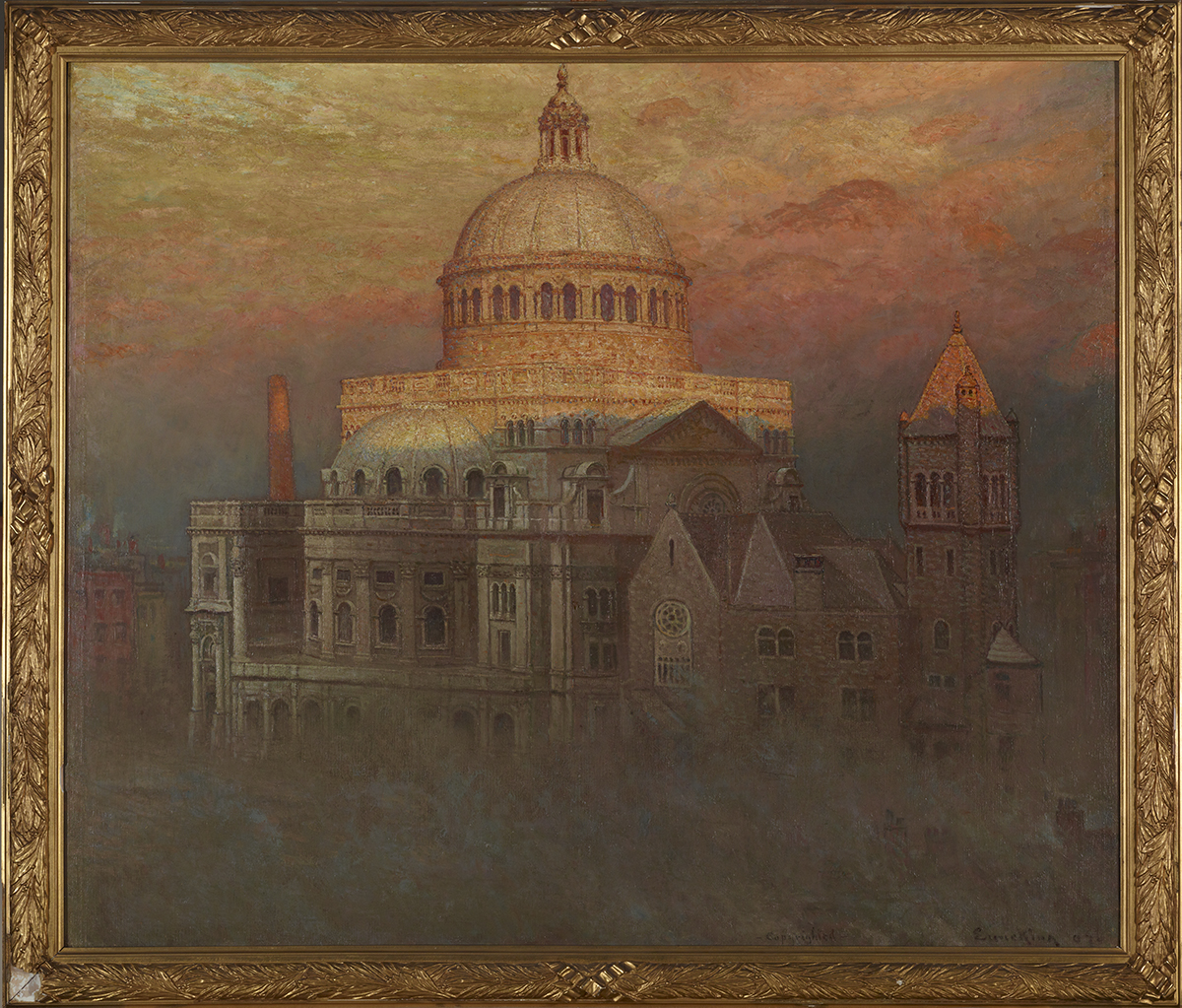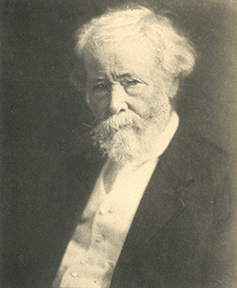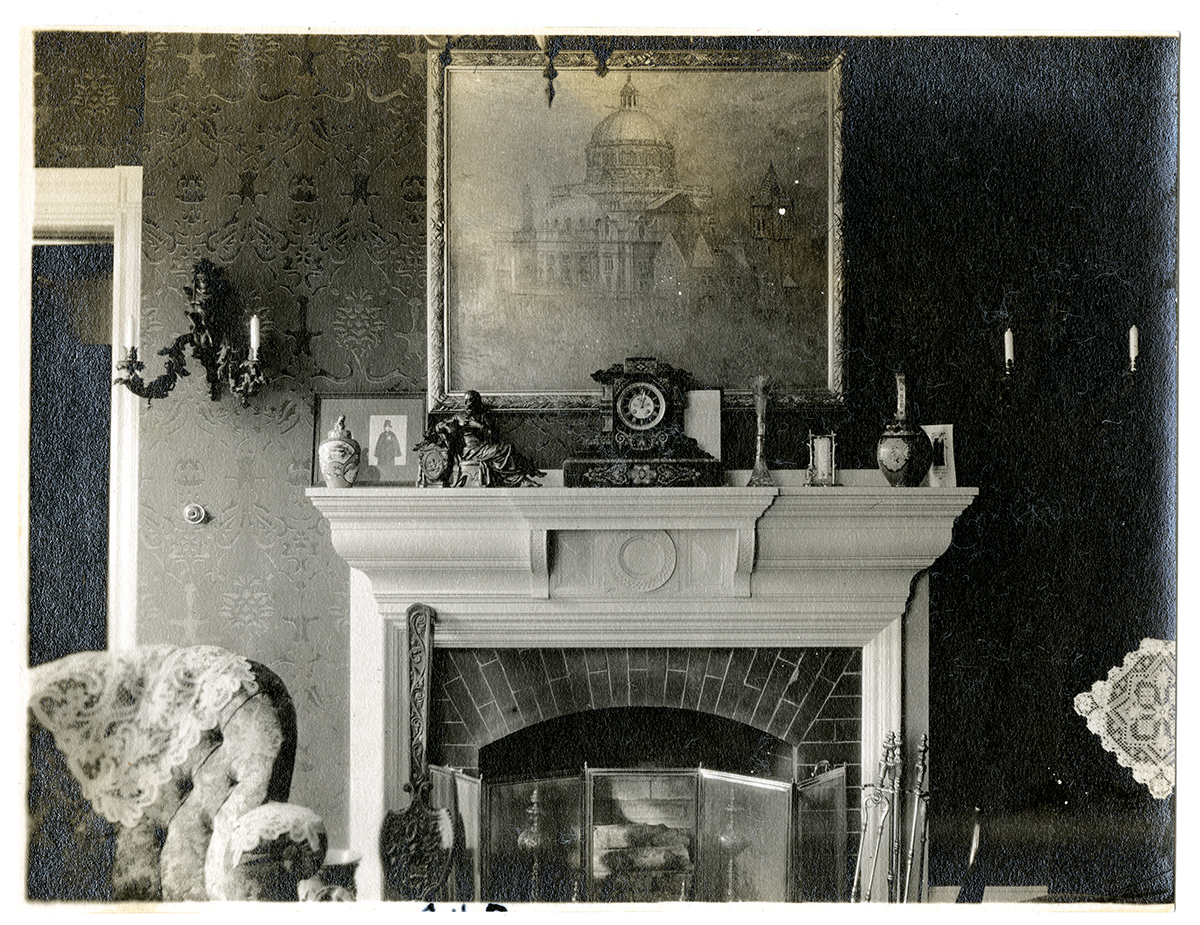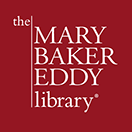The Dawn: “A Masterpiece of Skill”

The Dawn by John J. Enneking 0.1253.
In 1907 Mary Baker Eddy commissioned John Joseph Enneking (1841–1916) to paint a picture of The First Church of Christ, Scientist (The Mother Church). It hung prominently above the mantel in her home library at Chestnut Hill, Massachusetts. Here is the story behind this striking work of a distinguished American artist, titled The Dawn.
Not long after the dedication of The Mother Church Extension on June 10, 1906, William B. Johnson—a member of the Christian Science Board of Directors who was also serving as Clerk—received the following letter, written on behalf of Eddy by Pamelia Leonard, then working in Eddy’s home:
Mrs. Eddy has requested me to write to you saying that she wants you to see that a good picture of the Mother Church and the Extension as it stands today properly framed and sent to her.1
He asked William Lyman Johnson, his son, to have a picture made. Lyman Johnson took photographs of The Mother Church, which consists of two buildings: the 1894 Original Edifice, a Romanesque structure, and the domed Extension, with its Byzantine and Italianate features. From these photographs, father and son chose one view to send to Eddy. She approved of the view they had chosen, leaving it to the Directors to decide whether to have the picture made in oil or crayon.2
The Directors asked Lyman Johnson to find an artist who could “do justice to the subject.” A few days later he met with a group of artists, and a discussion took place about how a picture of the edifices could be depicted. (It is not clear whether Lyman Johnson gathered the artists together himself or if he attended a gathering that someone else arranged.) Lyman Johnson later remembered that no one in the group was interested in painting the more modest Original Edifice, along with the towering Extension, except for Enneking, who felt that a view from the right angle would create a very nice composition showing both buildings. The following day Lyman Johnson went to Enneking’s studio, where he saw sketches the artist had already made. In fact Enneking indicated he had wanted to make a painting of the churches ever since the new building was completed.3

John Joseph Enneking late in life, as photographed by John H. Garo
Enneking has been called one of the most important landscape artists of the late nineteenth and early twentieth centuries. Born in a small town in Ohio, he began drawing as a boy. After losing both of his parents within the same year, he went to live with a guardian, farmer Peter Gast, who may have been a relative. At 16 he saw his first art exhibit in Cincinnati. He learned the rudiments of drawing at the Academy of St. Mary’s in Cincinnati. He also learned the trade of tinsmithing.4
After serving in the Civil War, Enneking went to New York City to further his training in painting. He then moved to Boston, after hearing of its burgeoning art community. There he managed to sell enough paintings to finance a move with his family to Europe in the early 1870s. Travelling and painting, he finally arrived in Paris. There he saw the paintings of well-known European artists, including those who later came to be known as the Impressionists. Enneking painted with many of these great talents, including Renoir, Manet, Monet, and Pissarro. Corot and Millet became his friends.5
The family returned to the United States in 1876, making their home in the Hyde Park neighborhood of Boston. Enneking soon became a prominent figure in Boston culture and society, as a painter, teacher, and lecturer. He also loved nature and championed its preservation.
A painter of light and fascinated by its varying intensities, Enneking often did his work outdoors, where he frequently made “studies of every typical expression … of color, tone, and values as modified hour by hour by atmospheric effects ….”6 (Later he would transfer his studies to canvas in his studio.)
An essay in the catalogue Memorial Exhibition of Paintings by John J. Enneking describes Enneking’s painting vividly: “… he poeticized the whole subject, enveloped it in luminous waves of light, spiritualized it by thought and love until it became a shimmering, transfigured, tonal harmony.”7 This describes well his painting of The Mother Church. In a letter to Eddy, William Johnson described Enneking’s intentions for the painting as “to make the beauty of the noble dome, bathed in pure light, a symbol of Christian Science soaring above the shadows and the mark of material things.”8
In preparation for Enneking’s meeting with the Directors, William Johnson wrote to tell them about the artist’s skill and some of the prizes he had been awarded. They commissioned him to make the painting at an agreed-on price of $1,000—the equivalent of over $27,000 in 2020 dollars. In the confirmation letter, dated February 22, 1907, William Johnson reminded Enneking that he had indicated in a conversation with the Directors that the painting could be finished in four months.9 (It has been incorrectly reported that the cost of the painting was $10,000.)10
In the meantime, Lyman Johnson acted as liaison with the Directors and Eddy, providing Enneking with information about the size of the painting desired, as well as notes about the direction and quality of the light in the hallway where the work was intended to hang, at Eddy’s Pleasant View residence in Concord, New Hampshire. By July Enneking had completed a number of studies for the painting and had selected two for Eddy to choose between for the final painting. Lyman Johnson later recalled:
…One [sketch] was of both edifices by moonlight, very poetic and lovely, the lights of an evening [church] service shining through the windows of the new edifice towering upward among the stars …. The other sketch represented the churches at the moment a great storm had passed over them. The sidewalks were wet and steaming; the treacherous, brutal, storm-ladened clouds of blue-black … had broken apart just over the dome and the tower, and the sunlight streamed over them in morning brilliancy ….
Eddy liked both sketches, but ultimately chose the one of the defeated storm.11William Johnson wrote Eddy on July 26, 1907:
Mr. John J. Enneking, the artist who was selected to paint a picture of The Mother Church for you, has finished his work, and the Directors will be glad to send the painting to you as a loving gift from your Church if you will indicate that you are ready to receive it. Mr. Enneking has expressed a desire to go to your house and hang the picture so that it will show to the best advantage. Will it be convenient for you to have him do so?12
There is no evidence that Enneking visited Pleasant View. But the next day William Johnson wrote Eddy and enclosed a lengthy letter from Enneking, in which he explained his objective in painting The Mother Church. In his letter Johnson spoke of the artist’s accomplishments and skill, explaining that Enneking, though not a Christian Scientist, was “intensely interested in Christian Science” and observing that “[he] powerfully champions it”—this may in part explain his inspiration for the work.13 Enneking named the painting The Dawn, or, as he characterized it, “the Dawn of a new phase of religious expression,—based on life, truth and love.” He explained, “That thought or sentiment was more or less in my mind while painting the picture.” In describing his use of light and shadow as representative of Christian Science, Enneking used descriptors such as “glow of light,” “roseate morning light,” “a warmer glow,” “a whole mass of light,” and “reflected light”—the vernacular for which his paintings are most known.14
 The Dawn as it hung in the Library of Mary Baker Eddy’s home at Chestnut Hill. P05795
The Dawn as it hung in the Library of Mary Baker Eddy’s home at Chestnut Hill. P05795
Apparently The Dawn languished in a darkened place in Enneking’s studio for some time before Eddy received it. This may have been due in part to her preoccupation with the “Next Friends” lawsuit and her subsequent move from Concord to Chestnut Hill in January 1908.15 As a result of that delay, the paint suffered some weeping of surplus oil, which Enneking had to attend to before the work could be delivered. Because of the condition of its surface, Enneking felt that the colors would “tone” and the picture “become richer” once exposed to its new environment. He recommended that the painting not be varnished for at least three years. Although intended for display at Pleasant View, the work was at length delivered to Eddy’s new home at Chestnut Hill on March 30, 1908.16
Creating a painting of The Mother Church proved monumental for Enneking. He is reported to have had “moments of apprehension and of discouragement when the difficulties of presenting the edifices in an artistic manner seemed overwhelming.” Lyman Johnson also observed:
The picture is one that, like good friends, good music and good literature, is more appreciated when one comes in frequent and appreciative contact with it. It is one that, through its power and dignity, imagination and color-scheme, reveals its beauty and truth little by little. Owing to the difficulty of the subject and the way in which Mr. Enneking has handled it, I think that it is his masterpiece of skill in color, drawing and conception.17
Eddy acknowledged Enneking’s efforts in one very appreciative line: “Your picture of The Mother Church of Christ, Scientist, distinguishes the artist, points a history, and illuminates it.18
- Pamelia J. Leonard to William B. Johnson, 2 October 1906, F00795.
- William Lyman Johnson, Untitled and undated reminiscence on The Dawn, Subject File, Johnson, William Lyman, Re Enneking’s Painting – “Dawn, ” 2.
- William Lyman Johnson, Untitled and undated reminiscence on The Dawn, 3-4.
- “1860 United States Census,” s.v. “Peter Gast,” Ancestry.com. See also P. J. Pierce and R. H. Kristiansen, John Joseph Enneking: American Impressionist Painter (Hingham MA:, Pierce Galleries, Inc., 1972), which provides biographical information on the artist, some of it unsourced.
- Pierce and Kristiansen, John Joseph Enneking, 48, 55-63.
- Pierce and Kristiansen, John Joseph Enneking, 48, 55-62.
- Ralph Davol, “John J. Enneking,” essay in Memorial Exhibition of Paintings by John J. Enneking, Boston Art Club, March 2nd to 17th, 1917. The pages of this catalogue are not numbered; this quote is found on the fourth page of Davol’s essay.
- W. L. Johnson to Mary Baker Eddy, 27 July 1907, Box 536218, Folder 24947.
- W. L. Johnson to John J. Enneking, 22 February 1907, Box 18000, Folder 24948.
- Pierce and R. H. Kristiansen, John Joseph Enneking, 152.
- William Lyman Johnson, Untitled and undated reminiscence on The Dawn, 5-6.
- W. L. Johnson to Eddy, 26 July 1907, Box 18000, Folder 24948.
- W. L. Johnson to Eddy, 27 July 1907, Box 536218, Folder 24947.
- Johnson to Eddy, 27 July 1907, IC001fP2a.02.018; Enneking to Eddy, 27 July 1907, IC596.61.005.
- The “Next Friends” lawsuit was brought to determine Eddy’s competence to govern her own affairs. It began March 1, 1907, ended August 21, 1907, and was formally dismissed September 30, 1907.
- W.L. Johnson to Calvin A. Frye, 27 March 1908, IC153P2.24.018.
- W.L. Johnson to Eddy, 30 March 1908, IC153P2.24.019.
- Eddy to Enneking, n.d., V04982. This comment was published in the Christian Science Sentinel of 16 May 1908, along with Enneking’s letter to Eddy of 27 July 1907.

